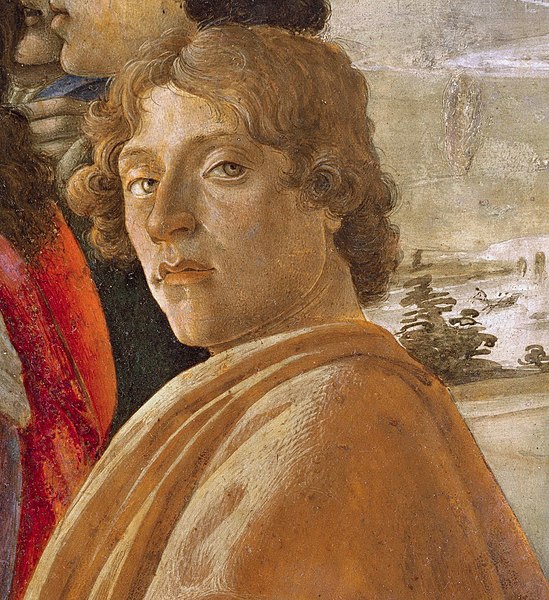
Born: c. 1445, Florence
Died: 17 May 1510 (aged 64-65)
Period: Renaissance
The Life of Sandro Botticelli
Sandro Botticelli, born Alessandro di Mariano di Vanni Filipepi in Florence around 1445, was a prominent Italian painter of the Early Renaissance. Known for his graceful and elegant style, Botticelli’s work is celebrated for its beauty, expressive figures, and intricate detail, embodying the spirit of the Florentine Renaissance.
Early Life and Apprenticeship Botticelli’s early life is not well documented, but it is known that he was born to a tanner, Mariano Filipepi, in Florence. He initially trained as a goldsmith before turning to painting. Around the age of 14, he was apprenticed to Fra Filippo Lippi, a master Renaissance painter known for his lyrical approach to painting. Lippi’s influence on Botticelli was profound, teaching him the importance of linearity and form, which became hallmarks of his style.
Rise to Prominence By the 1470s, Botticelli had established his workshop and began to receive commissions from some of the most prominent families in Florence, including the Medici, who played a significant role in his career. His talent for narrative and the decorative quality of his work quickly made him one of the most sought-after artists in Florence.
Notable Works Botticelli’s oeuvre includes religious subjects, mythological scenes, and portraits, with some of his most famous works being “The Birth of Venus” and “Primavera” (Spring). These paintings are renowned for their mythological themes, executed with an ethereal grace and a mastery of form and color that highlight Botticelli’s fascination with classical antiquity.
The Medici and Florentine Society The Medici family, particularly Lorenzo the Magnificent, were key patrons of Botticelli, and through them, he became embedded in the intellectual and humanist circles of Florence. This connection deeply influenced his work, imbuing it with Neoplatonic ideals, which sought to reconcile classical and Christian concepts of beauty and morality.
Later Years and Legacy The later years of Botticelli’s life saw a shift in his work, possibly reflecting the changing political and religious climate in Florence, including the rise of Savonarola. Some of his later works took on a more somber tone, reflecting the preacher’s influence. By the time of his death in 1510, Botticelli’s fame had been eclipsed by the next generation of Renaissance masters.
Despite this, Botticelli’s legacy endured, and his work was rediscovered in the 19th century, regaining its rightful place as a cornerstone of Renaissance art. Today, Botticelli is celebrated for his contributions to art history, particularly for his ability to capture the beauty of the human form and the complexity of human emotion. His paintings continue to be admired for their lyrical quality, elegance, and depth, securing his status as one of the masters of the Renaissance.
Sandro Botticelli’s Notable Works
Sandro Botticelli is a luminary of the Early Renaissance, renowned for his refined approach to painting that emphasizes grace and expressiveness. His works, marked by their lyrical beauty and classical themes, have left an indelible mark on art history. Here are ten of Botticelli’s most famous and influential works:
- “The Birth of Venus” (c. 1484-1486) – Perhaps Botticelli’s most iconic work, this painting depicts the goddess Venus emerging from the sea, embodying the ideal of classical beauty. It’s celebrated for its poetic and ethereal quality.
- “Primavera” (Spring, c. 1482) – This allegorical work is rich in symbolism, depicting a group of figures from classical mythology in an enchanted garden. It’s praised for its intricate detail and vibrant portrayal of spring’s renewal.
- “The Adoration of the Magi” (c. 1475-1476) – This painting, which includes portraits of the Medici family as the Magi, showcases Botticelli’s skill in composition and his ability to infuse religious scenes with humanism.
- “La Bella Simonetta” (c. 1485) – Allegedly a portrait of Simonetta Vespucci, a renowned beauty of Florence, this work is noted for its idealized depiction of feminine beauty.
- “Venus and Mars” (c. 1483) – A depiction of the Roman gods Venus and Mars, showcasing Botticelli’s talent for narrative and his interest in classical mythology.
- “Pallas and the Centaur” (c. 1482) – This painting, rich in allegorical meaning, depicts the goddess Athena (Pallas) subduing a centaur, symbolizing the triumph of reason over brute force.
- “The Annunciation” (c. 1489-1490) – Reflecting Botticelli’s mastery of religious themes, this work captures the moment the Angel Gabriel announces to Mary that she will bear the Son of God.
- “Calumny of Apelles” (c. 1494-1495) – Inspired by a description of a lost work by the ancient Greek painter Apelles, this painting is a complex allegory of innocence beset by slander.
- “Mystical Nativity” (c. 1500-1501) – This work stands out for its intense emotional expression and complex symbolism, reflecting the turbulent times of Botticelli’s later years, possibly influenced by the fiery sermons of Savonarola.
- “Portrait of a Young Man Holding a Medallion” (c. 1480-1485) – One of Botticelli’s many portraits, celebrated for its detailed rendering and the introspective gaze of the subject, showcasing the artist’s skill in capturing individual personality.
Botticelli’s legacy is defined by his ability to weave together the spiritual and the earthly, the mythological and the personal, into works of enduring beauty. His paintings are a testament to the intellectual and artistic vibrancy of the Renaissance, celebrated for their elegance, narrative depth, and profound humanism.